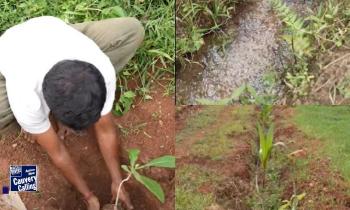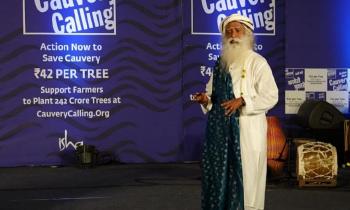Rallying to save rivers, and farmers too
Rivers meet one-third of the total irrigation and 20% of the drinking water needs of the country. Groundwater and other water bodies meet the rest of the demand. All the water resources are over-stressed and are depleting at an alarming rate.

The Rally for Rivers (RfR) team will throw light on the larger river problems in India and the world and share what they have been doing to address them through collaborative projects across India.
India’s rivers are depleting drastically due to various factors: over-extraction of water resources, deforestation, pollution, and climate variation. Major rivers are rapidly shrinking, and many perennial rivers have turned seasonal, not even reaching the oceans for many months of the year. Godavari has shrunk by almost 20%. Kaveri has shrunk by 40%, while Krishna and Narmada have shrunk by 60%.
According to estimates, by 2030 we will have only 50% of the water that we need for our survival. Furthermore, 25% of India is becoming desert. As compared to 1947, we have about 25% water per capita available today. Twenty-two out of thirty-two major Indian cities deal with daily water shortages. Water scarcity and drought are a reality for today’s generation in India. If priority action is not initiated to enhance water supply and reduce overexploitation, we may face a severe water and food crisis in 15-20 years.
Rivers meet one-third of the total irrigation and 20% of the drinking water needs of the country. Groundwater and other water bodies meet the rest of the demand. All the water resources are over-stressed and are depleting at an alarming rate. Surface water bodies like rivers are interlinked to the ground water bodies through aquifers. If rivers were to flow, the possibility of replenishment of other water bodies, is greater.
What can we do about this crisis?
The Rally for Rivers Draft Policy Recommendations takes all this into consideration in suggesting a solution. It is deliberately designed as primarily an economic model with an ecological benefit. Economic sustainability for all stakeholders is imperative for an idea as ambitious as revitalizing India’s rivers, to succeed.
Proposed solution: RfR proposes that for at least one kilometer-width on either side of all major rivers, and at least five hundred meters for smaller rivers, the land must have tree cover. The land should be under shade so that organic material in the soil can build up, retain water and allow it to percolate into the river. Where the government owns the land, afforestation is a must. Where farmers own the land, they must transition from regular crop farming to tree-based agriculture. This shift is a better economic proposition for an Indian farmer, as it can multiply his income at least 3 to 5 times.
Policy level solutions: Rivers must be recognized as a ‘national treasure’. Protection of rivers should encompass: a) ensuring full ecological flows; and b) preserving biological, chemical and physical characteristics of water that protect the gene pool. Rivers must be accorded due place in India’s development agenda, since they support a sizeable population directly and indirectly. Any effort to revitalize rivers should be in conjunction with improving the livelihoods of riverine communities. This will ensure ownership and economic benefits for the community and long-term protection and conservation of the river.
The technical sturdiness of this solution has been vouched for by experts from various fields including: policy making, hydrogeology, forestry, soil science, horticulture, micro-irrigation, Farmer Producer Organizations, agri-business, health and nutrition, and from the Food Safety and Standards Authority. While they all gave feedback about different details of the solution - which was fine-tuned accordingly - all were in agreement that the fundamental approach of tree plantation is a feasible and effective solution.
The proposed solution of large-scale tree plantation of native and endemic species in public land, and multi-tier tree-based agriculture in farmlands, must take into consideration all stakeholders. Every individual who consumes water is a stakeholder in revitalizing rivers.
What does it take to make our rivers flow?
Farmers and tribal communities have to plant trees. However, transitioning to multi-purpose/fruit tree cultivation involves a loss of income for the farmer until there is commercial yield from the trees. Therefore, the farmer’s notional loss of income should be suitably compensated by existing government schemes. This compensation for transition must be viewed as investment to ensure intergenerational equity of natural resources.
Consumers: Consumption of fruits and other tree-based produce must increase. Unless there is a demand for fruit and fruit-based products, it will not be economically viable for the farmer to invest in tree-based agriculture.
Nonprofits and governments: Large-scale awareness building initiatives are needed to effect a shift in consumer choices. Including fruits as 30% of the diet has enormous health benefits and will substantially increase the demand, making it viable for farmers to invest in tree-based agriculture.
Government departments: Effective implementation of an appropriate regulatory framework must happen, to control river pollution and prevent misuse of riverbeds by unsustainable sand mining. The former can be addressed by incentivizing adaptation of wastewater treatment technologies and heavy dis-incentivizing of polluters. For the latter, building and construction regulations can mandate use of alternatives to river sand like manufactured sand.
Industrialists must build partnerships with Farmer Producer Companies (FPCs). The government and industry (in PPP mode) need to develop clear branding and marketing strategies for fruits and processed products of Farmer Producer Companies. FMCG industries must have a clear strategy to collaborate with these FPCS for their demands.
The author Praveena Sridhar is a Lead Policy Expert at Rally for Rivers, Isha Foundation, and has several years of rich and diverse experience in water and related sectors. She has been a UNICEF consultant for a water and sanitation program and a consultant to other multilateral agencies and nonprofits.











